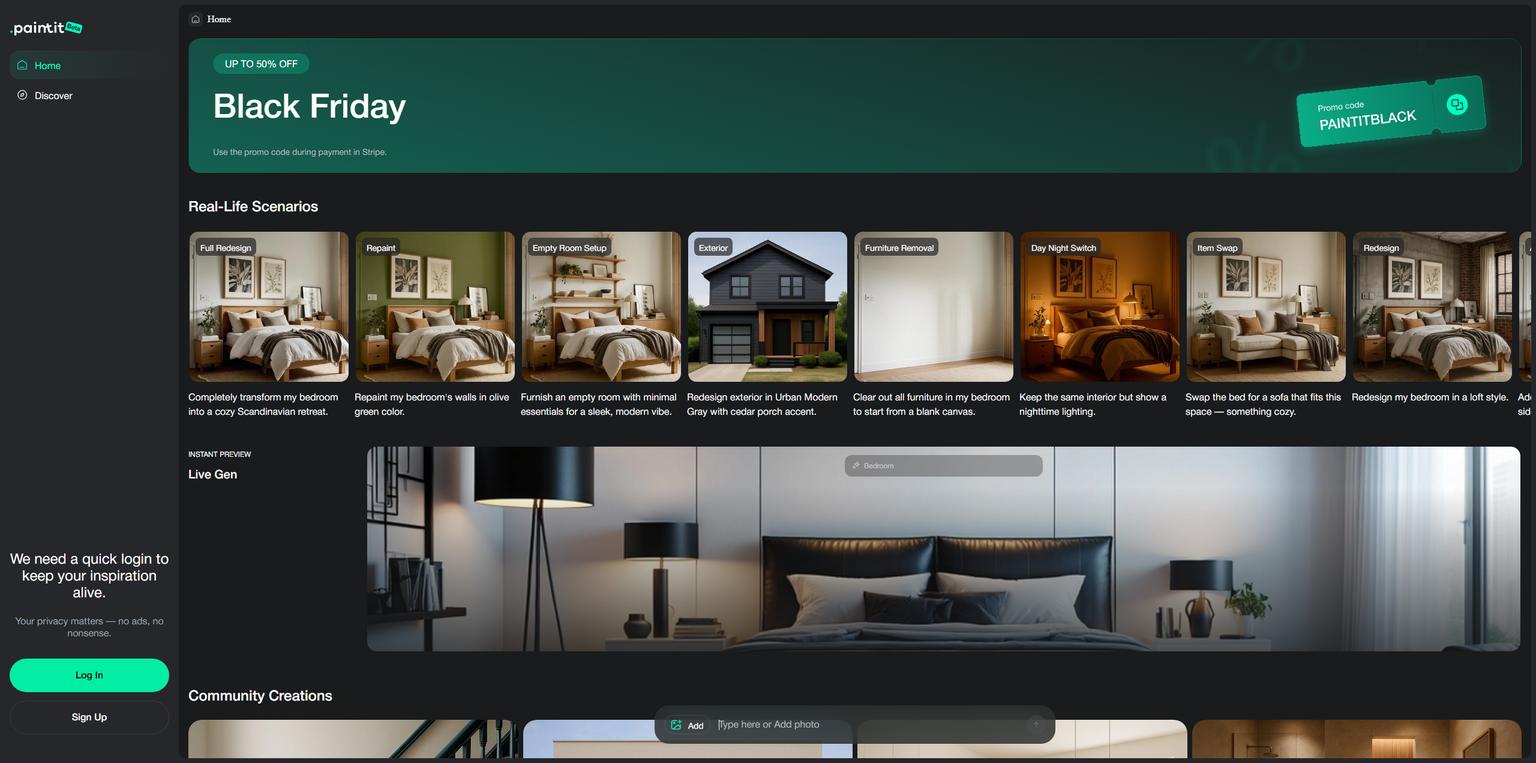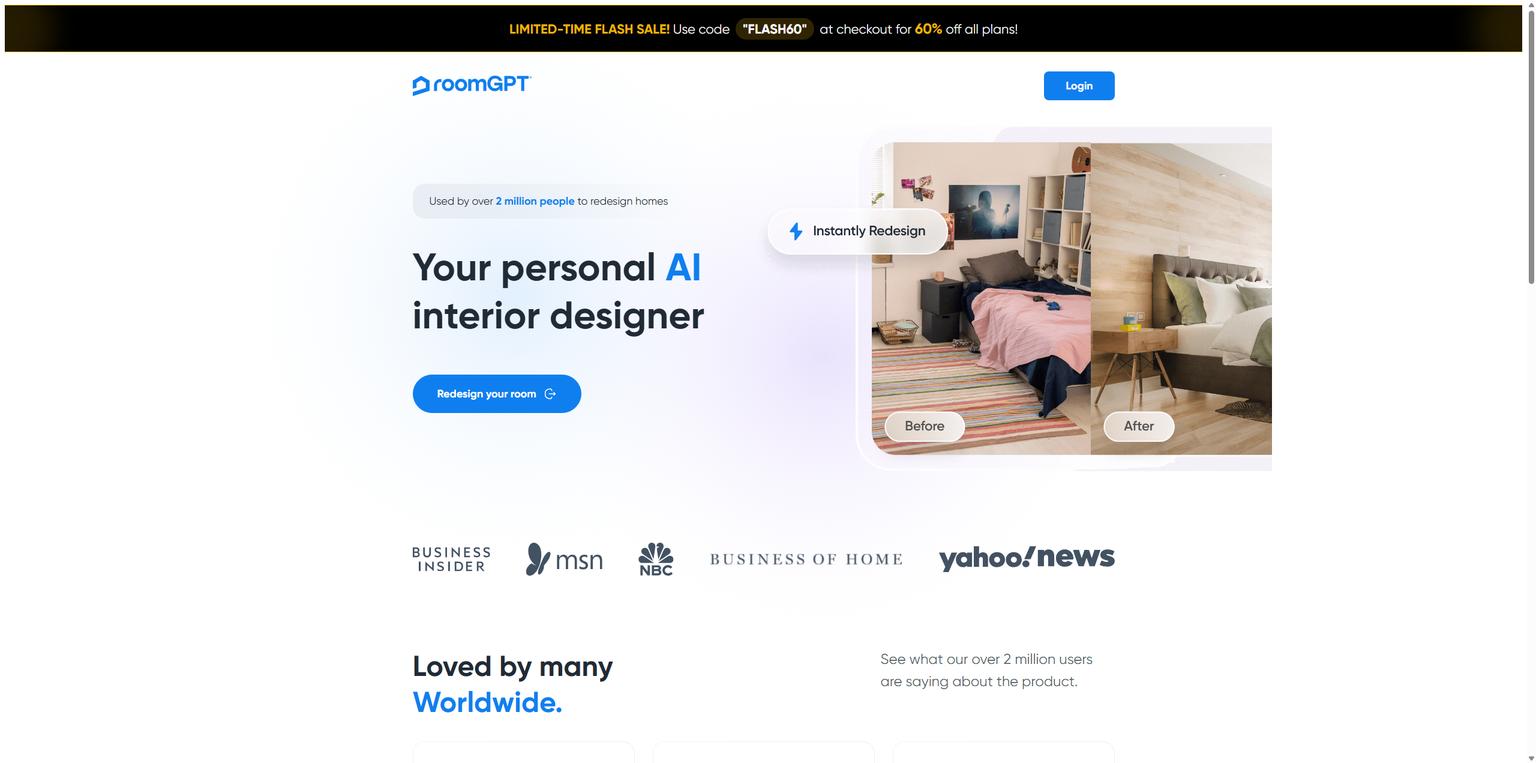6 min. reading

Page Contents:
- 1. Why Are Professionals Looking for Spacely AI Alternatives?
- 2. Top Spacely AI Alternatives: A Detailed Review
- 3. Comparison Table: Quick Feature View
- 4. Spacely AI vs. Paintit.ai: Which Tool Fits Your Workflow?
- 5. How Does "Agentic Commerce" Change the Game?
- 6. Frequently Asked Questions (FAQ)
- 7. Verdict: Which Alternative Should You Choose?
The global Architecture, Engineering, and Construction (AEC) industry and the real estate sector are currently undergoing a seismic technological transformation. For decades, the visualization of interior and exterior spaces relied on deterministic, labor-intensive processes. Architects utilized CAD software to build geometry line by line, followed by complex engines like V-Ray to simulate light. This workflow is inherently capital and time-intensive.
The emergence of Generative Artificial Intelligence (GenAI) has disrupted this paradigm. We have moved to a probabilistic era where algorithms utilize statistical probabilities learned from billions of training images to visualize spaces in seconds. This shift has collapsed the "render gap" and created a new market of tools vying for dominance.
Spacely AI has established itself as the current market leader for professional workflows, targeting architects who need high-fidelity results. However, a rapidly emerging challenger, Paintit.ai, is redefining the sector through e-commerce integration. This guide provides an expert-level analysis of this burgeoning landscape to help you navigate the choice between these platforms.
Why Are Professionals Looking for Spacely AI Alternatives?
To understand the competitive dynamics, one must appreciate the technological substrate these tools share. Modern tools utilize technologies like edge detection to "lock" the structural integrity of a room while allowing the AI to repaint the textures, lighting, and furniture.
However, this technological nuance creates a central tension: Fidelity vs. Flexibility.
Is the Credit System Draining Your Budget?
Spacely AI employs a tiered, credit-based subscription model. While powerful, this structure introduces friction. User feedback indicates a "love-hate" relationship with the credit system. Users note that credits are consumed rapidly when iterating to fix AI errors, leading to higher-than-anticipated costs. The pricing of these bundles varies by tier, incentivizing heavy users to commit to higher fixed costs.
Do You Need "Dream" Furniture or Real Products?
Spacely AI has positioned itself as the custodian of fidelity, targeting architects who need precise adherence to structure. However, for downstream users-agents and homeowners-the priority is often speed and shoppability. Traditional tools generate "dream furniture" that doesn't exist, creating a "fantasy gap." Alternatives are now closing this gap by integrating Agentic Commerce, where the AI helps you buy, not just visualize.
Top Spacely AI Alternatives: A Detailed Review
We have analyzed the broader competitive landscape to rank the top alternatives based on their strategic fit.
1. Paintit.ai

Best for: Real Estate Agents, Retailers, and Shoppable Design.
Paintit.ai is the superior strategic choice for those selling properties or products. It is not just a visualization tool but a sales enablement platform.
-
Shoppable Paradigm: Unlike competitors, Paintit.ai matches the generated items with purchasable products. This creates a high-intent marketing channel and automates sourcing for designers.
-
Visual Discovery: The interface allows users to click to apply styles like tracks in a playlist. This democratizes the technology, allowing an agent to stage a room on a tablet in real-time.
-
B2B Infrastructure: Paintit offers an AI Widget that retailers can embed directly into their own websites, allowing customers to see store sofas in their own rooms automatically.
2. Interior AI

Best for: Viral Speed and High-Volume Staging.
Interior AI gained early fame for its simplicity. It operates on a "freemium" model but has increasingly moved toward a paid subscription ($39/mo for Pro).
-
Differentiation: It is the "point-and-shoot" camera of the industry. It claims to help homes sell 87% faster via virtual staging.
-
Limitations: Its lack of fine-grained control makes it less suitable for precise design work compared to Spacely. It is a volume tool for agents who need to process 50 listing photos in an hour.
3. REimagine Home

Best for: Exterior Design and Curb Appeal.
REimagine Home creates a distinct niche by focusing heavily on the exterior aspects of real estate.
-
Unique Features: It includes specialized tools for Lawn enhancement and Sky replacement.
-
Market Fit: If Spacely is for the architect designing the house, REimagine Home is for the agent selling it later. It offers "pay-as-you-go" flexibility.
4. RoomGPT

Best for: Casual Users and Beginners.
At the bottom of the pyramid lies RoomGPT. While free or cheap, research indicates these tools are often "hit-or-miss," frequently generating "impossible furniture arrangements". They serve as a gateway for users to understand the technology but are generally incapable of professional output.
Comparison Table: Quick Feature View
The following matrix synthesizes the functional differences between the platforms.
| Feature | Spacely AI | Paintit.ai | Interior AI |
| Primary Audience | Architects, Interior Pros | Agents, Retailers, DIYers | High-Volume Agents |
| Input Flexibility | Sketch, Clay, Photo | Photo, Sketch (Basic) | Photo |
| Furniture Logic | Generative (Hallucinated) | Shoppable (Real Inventory) | Generative |
| Commercial Rights | Restricted to Studio ($38+) | Included in All Plans ($6.99+) | Pro Plan ($39) |
| Pricing Model | Credit Consumption | Subscription + Weekly | Subscription |
| Unique Feature | Sketch-to-Render | Agentic Commerce | Speed / Viral Styles |
Spacely AI vs. Paintit.ai: Which Tool Fits Your Workflow?
The choice between Spacely AI and Paintit.ai is not merely technical; it is a business decision. Spacely AI is the "Adobe Photoshop" of the space (complex, powerful), while Paintit.ai is positioning itself as the "Canva" with a commerce twist.
How Do Their Philosophies Differ?
-
Spacely AI: Focuses on utility and control. Its core value proposition is being "Built for Designers, Priced for Growth". It facilitates a workflow that moves from "clay" or "sketch" to final render. It includes features like negative prompting to specify what not to include and masking to mask a specific area of an image for regeneration.
-
Paintit.ai: Focuses on ease of use. It employs a radically different UX philosophy described as "designing like creating a playlist," where users visually select styles like music tracks. This lowers the cognitive load, making it accessible for users who require "push-button" solutions.
Who Wins on Pricing?
-
Spacely AI: Uses a credit consumption model. The "Starter" plan is ~$12.75/mo, but professional speed is gated behind the Studio Plan (~$38.25/mo).
-
Paintit.ai: Offers a disruptive $6.99 Weekly Plan. This acknowledges the project-based nature of many users. Crucially, Paintit.ai includes a Commercial Usage License even in its lowest-tier plans, whereas Spacely AI restricts commercial rights to higher tiers.
How Does "Agentic Commerce" Change the Game?
The most significant innovation in 2025 is the shift from visualization to transaction.
For furniture retailers, Paintit.ai offers a deep economic value: Return Reduction. Returns are a plague in online furniture sales. By using Paintit's widget to visualize a specific product in the customer's room before purchase, retailers can theoretically slash return rates, saving millions in logistics costs.
This feature allows Paintit.ai to serve as a high-intent marketing channel, moving the platform from a destination where you go to design to infrastructure that powers design everywhere.
Frequently Asked Questions (FAQ)
Is there a free alternative to Spacely AI?
While Spacely AI offers a free plan with 50 credits, it restricts users with slower queues. Completely free tools exist but lack quality. Paintit.ai offers a unique $6.99 Weekly Plan that bridges the gap, allowing for "sprint" usage without a monthly commitment.
Which tool is best for architects?
Spacely AI remains the benchmark. Its "Interior AI Render" capabilities allow professionals to generate a presentation-ready image in under a minute from a raw wireframe. Its upscaling algorithms sharpen blurry outputs into crisp visuals suitable for client boards.
Can I use AI generated images for commercial real estate listings?
You must verify the license. Spacely AI restricts commercial rights to its Enterprise or Studio tiers. Paintit.ai includes a commercial license in all plans, making it significantly more accessible for freelancers and the gig economy.
How can I remove furniture from a room before staging?
Both platforms offer tools for this. Paintit.ai's ability to "clean" the room (remove old furniture) via AI further enhances its value proposition for real estate agents dealing with messy properties.
Verdict: Which Alternative Should You Choose?
The landscape of AI-driven spatial design has bifurcated into two distinct paths.
-
Choose Spacely AI if: You are a professional architect. The ability to control structure via Sketch-to-Render and the nuanced masking tools justify the higher, credit-based pricing. It integrates into the "billable hour" model where quality is paramount.
-
Choose Paintit.ai if: You are a real estate agent, retailer, or homeowner. Its weekly pricing model aligns perfectly with the listing cycle. The ability to "clean" and "stage" a room with shoppable furniture provides an infinite ROI compared to physical staging.
For the user seeking an alternative to Spacely AI, Paintit.ai represents not just a cheaper option, but a fundamentally different philosophy-one that prioritizes the transaction of furniture and the speed of staging.
Trending
The Future of Design 2030: How Agentic AI & Paintit.ai Will Transform Your Home
Romantic & Cozy Navy Blue Bedroom: The Ultimate 2025 Design Guide
Agentic AI Commerce: How Furniture Brands Can Capture the Autonomous AI Buyer
Asymmetrical Balance in Interior Design: The Ultimate Guide to Dynamic Harmony
Mnml.ai Alternatives in 2025: Comparing the Top AI Design Tools for Architectural Visualization and Interior Design
Related articles

6 min read
What Are the Best Spacely AI Alternatives?
s Spacely AI worth it? Discover the best alternatives for architects and agents. Detailed review of Paintit.ai, RoomGPT, and others
Juliy Cherevko
CEO paintit.ai

5 min read
The Future of Design 2030: How Agentic AI & Paintit.ai Will Transform Your Home
Tired of managing renovations? By 2030, Agentic AI will do it for you. Explore Paintit.ai’s vision for autonomous design and the Agent-to-Agent economy
Juliy Cherevko
CEO paintit.ai

7 min read
Romantic & Cozy Navy Blue Bedroom: The Ultimate 2025 Design Guide
Create a romantic cozy navy blue bedroom with our expert guide. Discover 10 luxury dark blue ideas, best paint colors, and lighting tips for a dreamy sanctuary
Juliy Cherevko
CEO paintit.ai

7 min read
Agentic AI Commerce: How Furniture Brands Can Capture the Autonomous AI Buyer
Is your brand ready for autonomous AI buyers? Discover the 2025 roadmap, MCP integration, and how to partner with Paintit.ai for zero-click sales. Read now
Juliy Cherevko
CEO paintit.ai

10 min read
Asymmetrical Balance in Interior Design: The Ultimate Guide to Dynamic Harmony
What is asymmetrical balance in interior design? Discover practical tips for living rooms and bedrooms to create harmony without symmetry. Read more
Juliy Cherevko
CEO paintit.ai

10 min read
Mnml.ai Alternatives in 2025: Comparing the Top AI Design Tools for Architectural Visualization and Interior Design
Looking for an mnml.ai alternative? We compare the best AI tools for architects and designers: from 8K rendering and BIM integration to unlimited plans. Find your ideal design flow
Juliy Cherevko
CEO paintit.ai